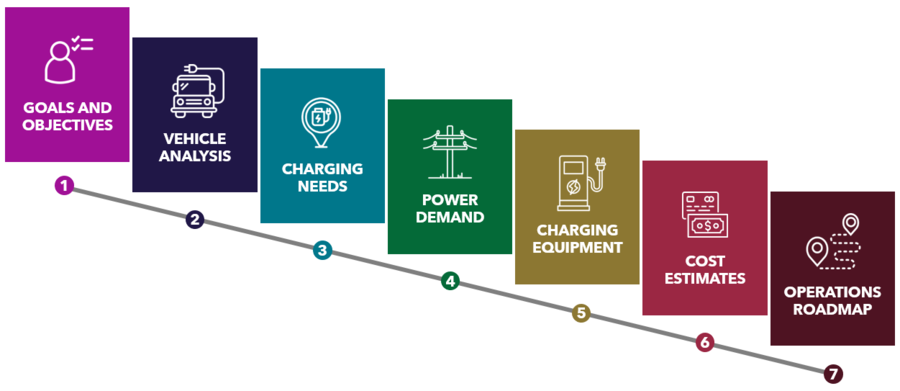The Importance of Developing a Framework for Fleet Electrification
Published 05-26-23
Submitted by Leidos

As managers of large vehicle fleets, both utilities and government entities are well positioned to be leaders in fleet electrification. In fact, many of these organizations are starting to put forth aggressive fleet electrification goals to support broader clean energy plans and internal carbon reduction objectives. However, the transition from fossil fuel vehicles to electric vehicles (EV) can often be complex and nuanced.
The path to successful fleet electrification requires careful planning and analysis that not only prepares for immediate EV needs but also future needs. The transition to an EV fleet must ensure that the power grid has sufficient capacity to deliver the additional electric load required to support EVs and charging infrastructure. To effectively execute a fleet electrification initiative, utilities and government entities need to employ a strategic framework that provides a comprehensive plan while also delivering the flexibility to adapt over time.
A Framework for Fleet Electrification
There’s no ‘one-size-fits-all’ approach to developing and executing a fleet electrification initiative. It is critical that utilities and government entities consider the wide range of factors that go into effective electrification - including EV fleet selection, charging needs, EV infrastructure logistics, required electrical infrastructure, existing power capacity, and site upgrades. Each of these factors will vary by organization and need to be tailored to the organization’s specific requirements. To support the journey towards 100% fleet electrification, utilities and government entities should consider a planning framework that focuses on seven core elements.
- Set clear goals and objectives. Organizations should agree upon a set of core goals, assumptions, factors, key values, and other references. Examples include mission objectives, fleet conversion goals, fleet usage decisions, external constraints, and input assumptions.
- Develop a detailed database that describes the makeup and key features of your existing fleet such as unique vehicle identifiers, domiciling information, mileage, and fuel usage, among other data points. This data is used to identify corresponding vehicle replacements and the characteristics of the replacement vehicle fleet including battery capacities, and potential charging schedules based upon duty cycles. For instance, organizations will need to compare options such as battery electric vehicles (BEV) versus plug-in hybrid electric vehicles (PHEV) to determine the vehicle type that best suits their needs.
- Create detailed usage models and trip statistics using available data drawn directly from the existing vehicle population or estimated using analogs. These models and statistics inform state of charge expectations, energy burden requirements, and charging objectives.
- Identify specific charging locations and power supply infrastructure required to support each location. Organizations should focus on an engineering analysis that utilizes load curves to model various charging options and optimizes capital requirements for the system at each location. The models assess total power demand, maximum point in time demand, energy replenishment, and managed versus unmanaged usage.
- Take the engineering analysis and develop specific lists of EV supply equipment and accessories necessary to meet the power requirements at each charging location in service of the assigned vehicles.
- Complete a cost estimation that encompasses equipment, engineering services, materials, construction labor, permitting, licenses, and other fees and provides a rational estimate for the development of each charging location.
- Estimate the total cost of ownership for the EVs and charging infrastructure, including any operations and maintenance (O&M) requirements and costs. As part of the total cost of ownership estimate, organizations should also consider the development of charging plans and policies as well as driver training needs.

As the EV market continues to mature and the supply of available vehicle types expands, utilities and government entities will be able to confidently undertake fleet electrification initiatives and overcome operational hurdles that have persisted in the past. And while fleet electrification can be a complex and nuanced process, proper planning and a well laid-out strategic framework will ultimately help large organizations reach their goals.
With more than 35 years of experience in the energy industry, Leidos is assisting utilities and government entities across the country with fleet electrification and carbon reduction initiatives. Our team has extensive experience in developing fleet electrification strategic plans and roadmaps, providing EV site studies, and helping organizations enact change management policies that are necessary with EV transitions. We understand that EV fleet needs are unique to each organization and we provide flexible support to maximize electrification initiatives. For more information on Leidos and our electrification support services, visit our Electrification web page.

Leidos
Leidos
Leidos is an industry and technology leader serving government and commercial customers with smarter, more efficient digital and mission innovations. Headquartered in Reston, Virginia, with 48,000 global employees, Leidos reported annual revenues of approximately $15.4 billion for the fiscal year ended December 29, 2023. For more information, visit www.Leidos.com.
More from Leidos

